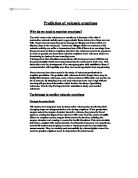Above: a picture of a volcanic eruption.
Why People Live Near Volcanoes
For centuries communities have grown up in the shadows of volcanoes. In Iceland, people use the energy from their island’s many volcanoes to provide heat and power. Other people live near volcanoes because the soil is rich and farmers grow crops and graze their herds on the slopes. In Indonesia more people live on the islands with active volcanoes than on the islands with none.
The volcano Mount Saint Helens is one of 15 in the Cascade Range of the north-west United States- an area where the Juan de Fuca plate is subducting beneath the North American plate. On 20 March 1980, a string of earthquakes north-west of the mountain peak signalled the slow awakening of the volcano, which had been dormant since 1857. A week later, a small eruption shot ash and steams into the air. Groups of scientists arrived with instruments to monitor the volcano. By early May, a bulge developed on the cone. This indicated magma rising in the volcano’s vent. The bulge grew bigger each day until a violent explosion, probably triggered by another earthquake, blew out the northern side of the mountain on 18 May. This caused and enormous landslide that devastated an area of 600sq km, (234 square miles) and triggered mudflows and floods. The blast killed at least 60 people.
Above: a picture of Mount Saint Helens in 1980 on May 18.
Ash
Millions of tonnes of ash shot 25 km (15 miles) into the atmosphere and the falling ash spread more than 1,500 km (930 miles) to the east. Ash fell like black snow in parts of Montana, Idaho, Oregon and Washington, and covered streets, cars and buildings. Cats and dogs downwind from the eruption turned pale grey from the ash that floated from the sky. But ash does not melt like snow and it has to be cleared. Most ended up in landfills.
Mudflows
Thick sticky mud caused by melting snow and ice sped down the North Toutle River Valley into communities below.
Trees
More than six million trees were uprooted or flattened by rock blasted from the volcano. After a massive salvage operation to clear the logs, seedlings were planted to replace the forests.
Plinian Plume
Minutes after the first explosion a second eruption produced a large Plinian column of ash and gas that rose to a height of 20 km (12 miles). This phase of the volcanic eruption continued for nine hours.






